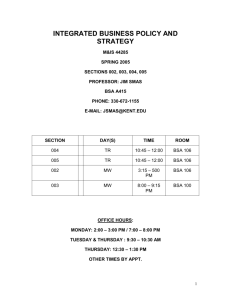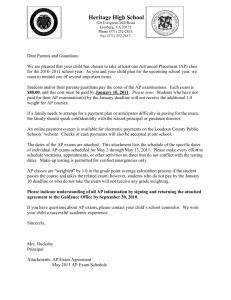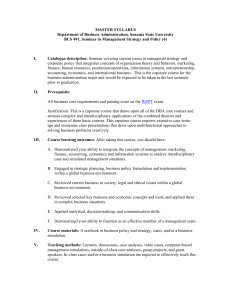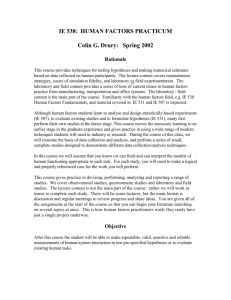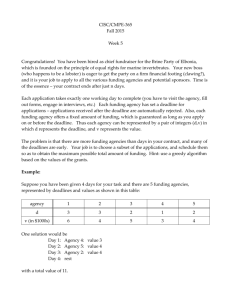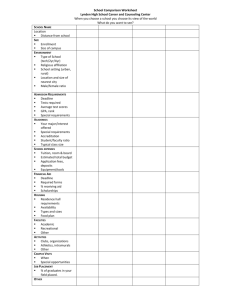M&IS 44285 Integrated Business Policy/Strategy
advertisement
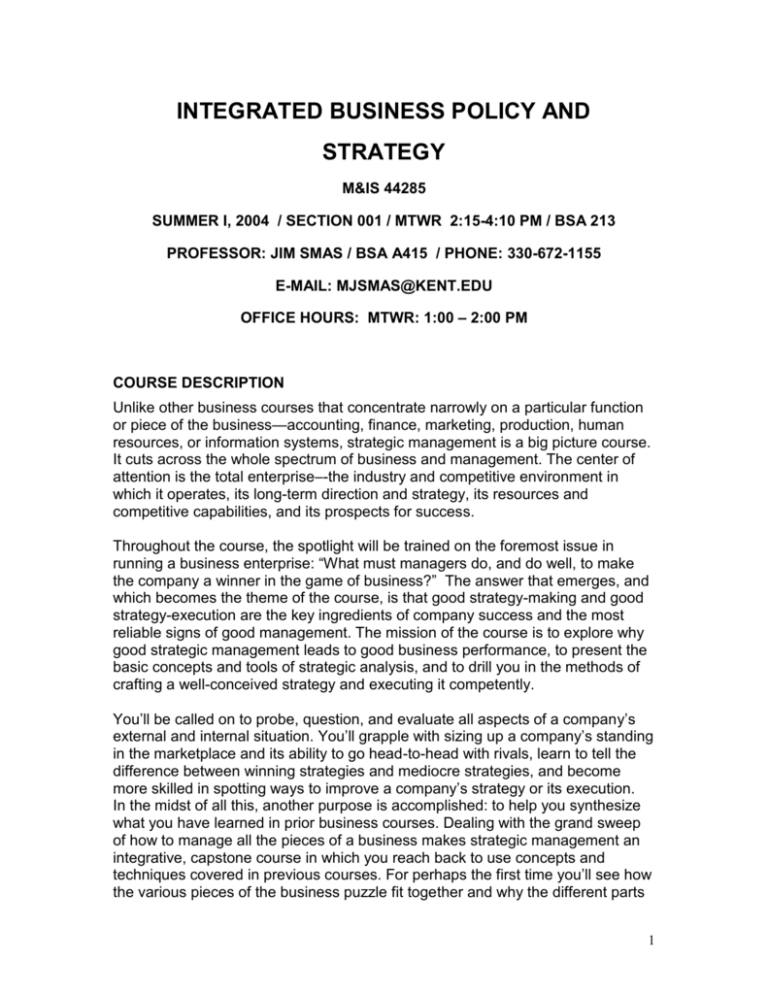
INTEGRATED BUSINESS POLICY AND STRATEGY M&IS 44285 SUMMER I, 2004 / SECTION 001 / MTWR 2:15-4:10 PM / BSA 213 PROFESSOR: JIM SMAS / BSA A415 / PHONE: 330-672-1155 E-MAIL: MJSMAS@KENT.EDU OFFICE HOURS: MTWR: 1:00 – 2:00 PM COURSE DESCRIPTION Unlike other business courses that concentrate narrowly on a particular function or piece of the business—accounting, finance, marketing, production, human resources, or information systems, strategic management is a big picture course. It cuts across the whole spectrum of business and management. The center of attention is the total enterprise–-the industry and competitive environment in which it operates, its long-term direction and strategy, its resources and competitive capabilities, and its prospects for success. Throughout the course, the spotlight will be trained on the foremost issue in running a business enterprise: “What must managers do, and do well, to make the company a winner in the game of business?” The answer that emerges, and which becomes the theme of the course, is that good strategy-making and good strategy-execution are the key ingredients of company success and the most reliable signs of good management. The mission of the course is to explore why good strategic management leads to good business performance, to present the basic concepts and tools of strategic analysis, and to drill you in the methods of crafting a well-conceived strategy and executing it competently. You’ll be called on to probe, question, and evaluate all aspects of a company’s external and internal situation. You’ll grapple with sizing up a company’s standing in the marketplace and its ability to go head-to-head with rivals, learn to tell the difference between winning strategies and mediocre strategies, and become more skilled in spotting ways to improve a company’s strategy or its execution. In the midst of all this, another purpose is accomplished: to help you synthesize what you have learned in prior business courses. Dealing with the grand sweep of how to manage all the pieces of a business makes strategic management an integrative, capstone course in which you reach back to use concepts and techniques covered in previous courses. For perhaps the first time you’ll see how the various pieces of the business puzzle fit together and why the different parts 1 of a business need to be managed in strategic harmony for the organization to operate in winning fashion. The Next Weeks Will Be Exciting, Fun, Challenging, and Filled with Learning Opportunities. No matter what your major is, the content of this course has all the ingredients to be the best course you’ve taken—best in the sense of learning a lot about business, holding your interest from beginning to end, and enhancing your powers of business judgment. As you tackle the subject matter, ponder Ralph Waldo Emerson’s observation, “Commerce is a game of skill which many people play, but which few play well.” The overriding intent of the course is to help you become a savvier player and better prepare you for a successful business career. We sincerely hope this course will prove to be instrumental in making you “competitively superior”, successful in your career, and much wiser about the secrets of first-rate management. REQUIRED TEXTS AND MATERIALS Parnell, Strategic Management, Atomic Dog Publishing, First Edition, ISBN: 1-59260-075-1 Siciliano and Gopinath, Strategize, South-Western Publishing, First Edition, ISBN: 0-324-06653-8 Team Member Guide,Foundation Management Simulations, Inc Simulation, version 2004. COURSE OBJECTIVES 1. To develop your capacity to think strategically about a company, its present business position, its long-term direction, its resources and competitive capabilities, the caliber of its strategy, and its opportunities for gaining sustainable competitive advantage. 2. To build your skills in conducting strategic analysis in a variety of industries and competitive situations and, especially, to provide you with a stronger understanding of the competitive challenges of a global market environment. 3. To give you hands-on experience in crafting business strategy, reasoning carefully about strategic options, using what-if analysis to evaluate action alternatives, and making sound strategic decisions. 4. To acquaint you with the managerial tasks associated with implementing and executing company strategies, drill you in the range of actions managers can take to promote competent strategy execution, and give you some confidence in being able to function effectively as part of a company’s strategyimplementing team. 5. To integrate the knowledge gained in earlier core courses in the business school curriculum, show you how the various pieces of the business puzzle fit together, and demonstrate why the different parts of a business need to be 2 managed in strategic harmony for the organization to operate in winning fashion. 6. To develop your powers of managerial judgment, help you learn how to assess business risk, and improve your ability to make sound decisions and achieve effective outcomes. 7. To help you become more proficient in using personal computers to do managerial analysis and managerial work. 8. To make you more conscious about the importance of exemplary ethical principles, sound personal and company values, and socially responsible management practices. GRADING PLAN/PERFORMANCE EVALUATIONS There are 1000 available points for the semester broken down as folows: Performance on simulation: 350 points 1. Actual perfomance of team in simulation (200 pts.) 2. Business plan ( Situation Analysis, mission etc. (75 pts) 3. Peer Review of ind. team members ( 75 pts ) 4. Bonus Points will be awarded to the best team where they will receive 25 bonus points. Written Cases 200 points Exams 200 points Final Project 150 points Class Participation ( as a team during in class case discusion) 100 points THE APPROACH TO TEACHING/LEARNING 1. Lectures by the instructor . 2. Practicing the tasks of managerial analysis and decision-making of inclass hrs.via use of actual case studies—analysis/discussion by whole class (students do most of the talking) 3. Practicing the task of managing via the management simulation Out-ofclass exercise. Teams of students must run their own company in a teammeetings, vigorously competitive industry environment (grade based on results achieved and degree of company success). 4. Experiential Exercises 3 5. Exams THE FOUNDATION SIMULATION OVERVIEW 1. The focus of the course is on managing a “real “company that is competing in a “real” industry. You will be part of a management team, which will be in charge of a specific company. Your team will be constantly analyzing the external, competitive environment, monitoring internal factors and making decisions for your company. You will compete against 3 – 6 teams in a world industry. The winning team in a world gets all the points for team standing and an additional 25 points as a bonus... 2. You will do two practice rounds after mastering the Internet web site for Capstone and the relevant software. It will take some time for your team to ramp up and be comfortable with the inputting of decisions and uploading to the web site. All calculations of spreadsheets and financial ratios are done by Capstone and can be downloaded after each round for further analysis. After the practice round, you will then do 7 rounds of decisions, which will represent one year per round. Capstone will determine which team did the best against various criteria and rank the teams accordingly. All judging will be done by Capstone, not the professor. Teams that finish in the top third of their world receive all 200 points for team standing. Teams in the second third will receive 150 points and the teams who finish in the lower third, receive 100 points. You will receive points also for your situation analysis, business plan, and final recap of simulation. TEAMS 3. Management teams will consist of 5 -6 students. You should try to obtain some degree of diversity among skills, like having computer, finance, marketing, and operation management skills available to the team. 4. Each team member must log onto the website as a team member. The fee for the simulation per person is $39.95. Each team member is expected to contribute his/her fair share of work. At the end of the simulation, a peer review will be taken in complete confidence to assure that all players contribute equally. MAKING DECISIONS 5. Company decisions must be uploaded to the www.capsim.com web site no later than 5 pm on each designated day of the simulation Results 4 should be available by that evening. The dates of the various rounds are listed below: 1. 2. 3. 4. 5. 6. 7. 8. 9. Practice round 1deadline: Practice round 2 deadline: First round deadline: Second round deadline: Third round deadline: Fourth round deadline: Fifth round deadline: Sixth round deadline: Seventh round deadline: June 16 June 17 June 22 June 24 June 29 July 1 July 6 July 8 July 13 6. The web site also offers the opportunity for teams to meet and discuss their pending decisions. There are numerous tutorials and help is available from Capstone help line 888-472-7554.During normal business hours. ASSIGNMENTS Note: due dates for these assignments will vary according to sections, and the student should refer to the Detailed Schedule of Class Content for due dates of the following assignments. 7. Initial Situation Analysis Each team will prepare a concise report on the status of their company at the start of the simulation. This report will clearly detail the strengths, weaknesses, opportunities, and threats (SWOT.) There is a chapter in the team member guide on the situation analysis. This report should be limited to four typed pages of text with as many charts as you deem appropriate at the end of the report. 8. Business Plan: Part A. Each team will prepare a report detailing the mission statement of the company, the objectives and business strategy they plan to use to attain these objectives. These reports should be limited to a maximum of three typed pages or less. Examples of such reports will be provided for your examination. 9. Business Plan: Part B Each team will prepare a report detailing, round by round, what happened. This report should explain (concisely) what the team planned to accomplish in the round and compare this to what actually happened. This report should end with a brief discussion of the important successes and failures, which occurred during the Team’s tenure as managers of the company. This report should be typed and no more than 5 pages of text with as many charts or exhibits as you deem necessary at the end of the report. 5 POLICIES REGARDING CLASS ATTENDANCE, PARTICIPATION IN CLASS DISCUSSIONS OF ASSIGNED CASES, AND COMPLETION OF ASSIGNED CASE EXERCISES Attendance at all class sessions is expected You are required to complete a case preparation exercise for the assigned case Due to the fact that participation in class discussion of cases counts as a factor in determining your overall grade in the course, each TEAM MUST contribute significantly to in-class analysis and discussion of the cases. Each student is expected to be an active participant in case discussions and to offer meaningful analysis and convincing arguments for the position you stake out. Your grade on class participation is something to be earned by contributing your assessments and judgments to the discussion. Merely coming to class and listening to the discussion of assigned cases is not sufficient; attendance is not participation. You should, therefore, make a conscientious effort to be sufficiently prepared to make intelligent, timely comments regarding the managerial issues raised in the cases. This entails reading the assigned cases, completing the accompanying exercises and bringing the completed printouts to class (to use as notes in making your comments). . A contribution is defined as making a relevant and clearly articulated statement, either in response to a question by the instructor or in response/rebuttal to comments made by another class member. Merely saying “yes” or “no” without any elaboration or saying a few words without having the full attention of the class does not count as meaningful participation. Because of the large number of students in most classes, team grades will be assigned for participation and all team members will get the same grade for participation. Thus you should do your best to help your team score big. EXAMS There will four short exams or quizzes, which will be of the multiple-choice type with perhaps a single essay question, or two. They will be given at the beginning of each week. They are worth 50 points each. PREPARATION OF WRITTEN CASE ASSIGNMENT The written case assignment is to be prepared on an individual basis or as a team. It is expected that the content of your written case will reflect your thoughts and analysis rather than the work of others. 6 Some suggestions regarding the preparation of written case assignments are described below. The criteria for grading written case presentations include: 1. Identification of key problems/strategic issues. 2. Use of appropriate analytical tools techniques, including the use of charts and tables where appropriate. You are expected to demonstrate that you can use the tools and techniques of strategic analysis presented in the chapters. Both breadth and depth of analysis will be evaluated. 3. Presenting realistic, workable, well-supported recommendations for action. 4. Use of good communication skills—failure to use good grammar, spelling, and other written communication skills will result in a full one-letter grade reduction. 5 Evidence of adequate preparation, pride of workmanship, and display of professional attitude and approach. We will describe a Strategic Audit Procedure which will be used to provide a template for the written case analsysis. Cases turned in after the due-date are eligible for a grade no higher than a C (and that only if the paper is otherwise an A or B+ paper). No late papers will be accepted if submitted more than 2 class days past the scheduled due date (except by prearranged consent of the instructor). All written cases are to be typed (1.5 spaced) and should incorporate correct form, spelling, grammar, sentence structure, and communication skills. Papers which, in the opinion of the instructor, employ disproportionately poor grammar and poor quality written communication skills will be assigned a grade that is a full one-letter lower than would otherwise be assigned. TEAM PROJECT A basic model of strategic management stipulates that there be a fit between the firm and its environment in order for the firm to achieve its long-term goals. Both of the projects described below provide a framework for analyzing the strategy of a firm in relation to its environment. You have a choice to select one of two team projects outlined below. Teams that work on Project A will compare and contrast the strategic issues faced by two competitors in the same industry. If access to a local company is possible, then Project B is another option that gives teams an opportunity to analyze the strategic management processes and its various components at a nearby firm. 7 Project A: Comparing two organizations in the same industry. Phase I Industry analysis 1. Choose an industry 2. Gather information on the industry 3. Analyze the industry. What can you conclude about the attractiveness of the industry over the next three years? Phase II. Two Competitors in Industry Identify two companies that are operating in the industry you have studied. Preferably, choose two that have very different performances in the recent past. Divide the team into two subunits, and each unit will focus on one firm. 1. Each team subunit should identify the current strategy of the firm and appraise its internal resources and capabilities. How is the current strategy incorporating these competencies and helping the firm compete within the industry? 2. Evaluate the current performance of the firm. How successful has the strategy been in generating an above average financial performance for the firm over time and relation to the industry and competitors? Phase III Final Analysis Reunite both subunits of the team and conduct the final analysis 1. Compare the two firms. Faced with the same industry environment, examine how and why the firms pursued the strategies they did. 2. What are your recommendations for these firms? How would you change their strategies? What recommendations do you have for implementation? Project B: Identifying strategic issues at local business organizations. Phase I. Company Selection Identify an organization in your local community. This must be a firm that you have access to, both physically in terms of being able to visit the offices and plants, and in being able to meet with and interview at least one company official. The company may be small, medium, or large and could operate in either the forprofit or nonprofit sector. If it is a large organization with divisions in several industries, such as Phillip Morris, choose one of the divisions for this study. Your choice should cover only one industry. Phase II: 1. 2. 3. Industry Overview Identify the industry in which the organization or division competes. Gather information on the industry Analyze the industry. What can you conclude about the attractiveness of the industry over the next three years? 8 Phase III: Strategic Issues Identification 1. Identify one or two major strategic issues the company faces. To develop a summary of the issues either of the following: a. Develop a table of the definitions strategy applied to the company. Analyze results from an intended versus emerged strategy perspective, which the definitions help to clarify. b. Examine the current status of each of the parts and processes of strategy. The strategic issues are the elements that do not fit. 2. After undertaking your analysis based on publicly available information, meet with company officials and discuss your findings. Use their input to further refine your analysis. REPORT (150 POINTS) Present your project work in the form of a written report. In the case of Project B, you may consider giving a copy of your report to the organization, or inviting the company official who was your contact to the class presentation. Your written report should: 1. Be no more than about 6000 words (12 Pages). Place all tables and charts in appendices in the end. 2. Organize the report to follow the phases of the project. 3. Conclude with a complete list of references, web sites, and interviews that were sources of information The Following Policies Apply to All Students in this Course A. Students attending the course who do not have the proper prerequisite risk being deregistered from the class. B. Students have responsibility to ensure they are properly enrolled in classes. You are advised to review your official class schedule (using Web for Students) during the first two weeks of the semester to ensure you are properly enrolled in this class and section. Should you find an error in your class schedule, you have until Friday, September 5, 2003 to correct the error with your advising office. If registration errors are not corrected by this date and you continue to attend and participate in classes for which you are not officially enrolled, you are advised now that you will not receive a grade at the conclusion of the semester for any class in which you are not properly registered. C. Academic Honesty: Cheating means to misrepresent the source, nature, or other conditions of your academic work (e.g., tests, papers, projects, assignments) so as to get undeserved credit. The use of the intellectual property of others without giving them appropriate credit is a serious academic offense. It is the University's policy that cheating or plagiarism 9 result in receiving a failing grade for the work or course. Repeat offenses result in dismissal from the University. D. For Spring 2004, the course withdrawal deadline is March 20, 2004. Withdrawal before the deadline results in a "W" on the official transcript; after the deadline a grade must be calculated and reported. E. Students with disabilities: In accordance with University policy, if you have a documented disability and require accommodations to obtain equal access in this course, please contact the instructor at the beginning of the semester or when given an assignment for which an accommodation is required. Students with disabilities must verify their eligibility through the Office of Student Disability Services (SDS) in the Michael Schwartz Service Center (672-3391). SCHEDULE FOR SUMMER I 2004 10 11
